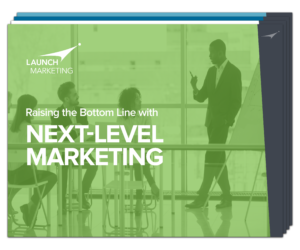Have you ever taken part in an Escape Room with a group of friends, or perhaps embarked on an immersive parachuting excursion? Maybe you’ve live streamed something on YouTube or Facebook? What you may not have realized about each of these is their representation of some of the cutting-edge tools and experiences marketers are employing in their modern campaigns.
These less traditional marketing tactics are part of a relatively new wave of marketing —experiential marketing, or sometimes referred to as engagement marketing. While experiential marketing is commonly employed by B2C marketers, B2B marketing has begun to develop many characteristics of its consumer-focused counterpart in an effort to deliver the seamless B2C experiences business buyers have come to expect.
To understand why experiential marketing has become such a valuable tool for many marketers, we must first understand what experiential marketing is.
Experiential Marketing in Practice
A common first instinct is to assume “event marketing” when you think of experiential marketing. However, events are just one of many experiential marketing applications. While some experiential tactics may revolve around a central event your prospects can attend, other experiential marketing campaigns might not even incorporate in-person or group setting experiences.
For instance, the Google Impact Challenge hosted in the Bay Area was arranged by Google as a way for members of the Bay Area to participate in selecting the local nonprofits that would receive Google-funded grants worth $250,000 to $500,000. To gather the votes, Google placed interactive posters throughout the Bay Area where people could vote at their convenience on the nonprofit they thought would most positively contribute to their community.
This is a prime experiential marketing example because participants were exposed to, and interacted with, the Google brand in a distinct and memorable fashion. Even without directly interacting with a Google team member (or anyone at all, for that matter), participants still learned about Google’s core values in an inventive way.
Focus Points of Experiential Marketing
From growth marketing to email marketing, there are best practices that allow you to excel and take full advantage of your marketing skills. Despite its modern status, you might be surprised that many of experiential marketing’s best practices are rather familiar and applicable across channels.
1. Research Your Target Audience
Before you begin crafting a highly unique experience, you need to understand what your audience is looking for. Returning to the Google experiential marketing example, the tech powerhouse was able to intimately communicate with Bay Area residents because they had the proper understanding of the community they were engaging with.
In the same sense, you want to understand how your audience wants to be outreached to. If you’re a B2B company distributing a software that requires a certain skillset for even basic interaction, something like the Google experiential marketing campaign wouldn’t make much sense. Instead, understand where your audience dedicates most of their time to learning about external resources. Some questions you can start with:
- Is your prospective audience on social media? If so, what channels?
- Do they prefer occasional emails with highly detailed content, or more regular emails with general high-level content?
- Do they want a simplified video explaining the product?
2. Focus on the Power of Storytelling
Effective marketers are emphasizing storytelling in their campaigns and strategies. Storytelling sets your brand apart from the constant noise that many buyers are inundated with.
Experiential marketing allows your brand to tell your story in a more creative way. For instance, Refinery29, a lifestyle publication geared towards modern women, hosted a 29Rooms event themed, “Turn It Into Art” that highlighted their brand through the lens of partner companies. By allowing partners to design each of the rooms to reflect their respective brands, Refinery29 created an experience that not only allowed attendees to experience something new and inspiring, but also demonstrated their focus on collaboration, art and technology.
3. Bolster Your Social Media Marketing
A great way to make your experiential marketing more engaging and spread the experience is through social media. For example, a hashtag associated with your experiential marketing campaign can serve to pique initial interest. If you start to propagate the hashtag within your content and social posts, followers will be curious to learn more.
Not only does social media help with the pre-planning of your experiential marketing, but it also plays a role in the post-campaign. When people took part in Lean Cuisine’s #WeighThis experiential marketing campaign, the campaign ultimately led to 204 million total impressions. Just a single hashtag placed on the participants’ posts led to a high volume of people participating in the experience and ultimately learning more about the Lean Cuisine story and brand.
Making Experiential Marketing Work for B2B
Creating an All-Encompassing Journey
When you think about the customer’s journey, especially if you’re a company offering bigger ticket items, customer decisions are not going to be made at the drop of a hat. On average, buyers are spending about 79 days gathering information on your company and your products in order to make an educated purchase decision. So, within that almost three-month period, why not provide them with a journey that stays with them, while also being representative of your brand?
If your experience isn’t focused around an event, but perhaps on a fresh interactive feature on your website, think about the experience from each buyer’s perspective. What if this is their first interaction with your brand? Maybe they’re a past client that has fallen out of touch. In every case, it’s vital to ensure every interaction with your brand is a positive and impactful one.
As we saw with the Google experiential marketing example, you should ensure that you’re aligning with the customer’s journey, not fitting them into your campaign. Be sure to bring the experience to them and make it as convenient as possible for them to participate.
Think Outside the Box
There is a growing number of experiential marketing examples, and as you’ll continue to see in each, the common thread is creative thinking. While there are guiding best practices to follow as previously discussed, there isn’t a precise formula to experiential marketing. It’s important to think beyond your organization’s general marketing scope when developing an experiential marketing strategy.
For B2B marketers, are there current events happening or community spaces built around your product or industry where you can incorporate your brand? You can use these events as inspiration for what you want to achieve, and then expand with your own creative flair and storytelling.
Understanding How to Speak to Your Audience
In the B2B market, it can feel harder to incorporate the same creative flair traditionally left to the B2C world. But more and more B2B customers appreciate marketers who show a real interest in marketing to them effectively and distinctively, considering 74 percent of customers view brands more positively once they’ve attended an event or experience.
Be sure to consciously create an experience that is cohesive with your brand’s story and makes sense to the customer. While your first dip into the experiential marketing pool may feel like a big pivot away from your traditional marketing efforts, you can learn and adjust your experiential strategy as you go to ensure it’s attune to both your brand and your audience.


There are no comments